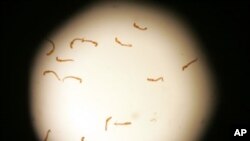Over a billion people, one in every six people living on this planet, suffer from one or more neglected tropical diseases, or NTDs. NTDs are a group of tropical infections which are especially common people with little or no access to clean water and sanitation, who live in the poorest regions of Africa, Asia, and the Americas.
These usually treatable and preventable diseases include schistosomiasis; Elephantiasis; Trachoma; Chagas Disease; River Blindness; Leprosy; Kala-azar, dengue, black fever and other forms of Leishmaniasis; and the three most common infections -- the soil-transmitted parasites hookworm, roundworm and whipworm.
Neglected Tropical Diseases have blinded, disabled disfigured and killed their victims for centuries. Their impact on individuals and communities is devastating. They impair intellectual development in children, and reduce school enrollment. They limit the ability of infected individuals to work and thrive, thus trapping them in a cycle of poverty and disease.
The diseases are dubbed Neglected because they are found in the poorest, rural areas of the developing world and for centuries were seen as diseases of forgotten people. They are often found together with HIV/AIDS, Tuberculosis, and Malaria.
In 2006, the non-profit, Washington-based Sabin Vaccine Institute launched the Global Network for Neglected Tropical Diseases to highlight and mobilize resources for treating and eventually eliminating NTDs. Soon the Network acquired two prominent partners: the World Health Organization, and the United States government.
That same year, the U.S. Congress set aside funding for NTDs, and then-President George W. Bush announced a new NTD initiative, pledging more funding. Three years later, President Barack Obama announced the Global Health Initiative, which expands efforts to tackle NTDs, and includes a new focus on elimination of some of the targeted diseases such as River Blindness, Elephantiasis, Trachoma and Leprosy.
By the end of 2011, the United States Agency for International Development, which administers the U.S. NTD program, leveraged 3.1 billion dollars in donated medicines. As a result, some 232 million people received 532 million treatments.
In January 2012, the U.S., U.K. and United Arab Emirates governments came together with global pharmaceutical companies, the Bill & Melinda Gates Foundation, the World Bank and other global health organizations to accelerate progress toward eliminating or controlling 10 neglected tropical diseases by the end of the 2020.
In cooperation with our partners, we will continue to work toward mitigating the impact of Neglected Tropical Diseases on vulnerable populations, with the goal of eventually eliminating them as major threats to human health.
On Neglected Tropical Diseases

Over a billion people, one in every six people living on this planet, suffer from one or more neglected tropical diseases.

















